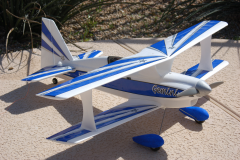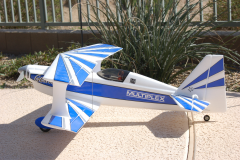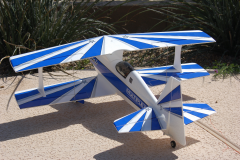


I’ve had the opportunity to fly the Gemini for a while now so it’s time for a review. I’ve had the build log posted for a while already so this review will focus primarily on my reactions to the model as part of the airplanes in my hangar.
 |
 |
The Gemini came neatly packed in a box with the typical Multiplex colorful styling. Inside was a different matter. Unlike the other Multiplex models I’ve opened, the Gemini came in a foam rack with the parts cleverly mounted to prevent movement during shipping and handling. Everything was damage free when I examined the kit. Like most Multiplex models the parts count is fairly low. The model goes together fast with little hassle. As noted in the build log, this kit was the first Multiplex kit I’d gotten with a part that didn’t fit. It had two lengths of wire for the tail surfaces that were equal length. Unfortunately the recesses in the side of the fuselage were not equidistant from the tail!. Fortunately, music wire is easy to get at any local hobby shop.
Unlike with several of my Multiplex models, I decided to use the bright blue decals that came with the Gemini. I’ve found that sanding off the bumps is a good move if painting; it’s not so good if using the decals. The decals stick much better to the smooth surface of the Elapor foam better than when it has been sanded. The assembly techniques are the same as for other Multiplex models. The primary tasks are to glue the control rod snakes to the outside of the fuselage, mount the servos in their respective molded recesses, glue in the wing attach plates, motor mount and hatch latches to the inside of the fuselage halves, then glue the halves together. Vertical and horizontal stabilizers mount easily and in the case of the Gemini, the tail wheel needs to be attached before completing the rudder assembly.
Here are some of the critical statistics for my Gemini. Please take a look at the Gemini Build Log here for more information on the assembly and components as well as a link to the Gemini manual.
| Wingspan | 36 inches |
| Fuselage | 36 inches |
| Weight | 30 ounces |
| Prop | APC 10 X 5 |
| Motor | Suppo 2814 6 turn |
| Battery | 11.1v 2100 mAh |
| Watts | 210 |
| Ams | 25 |
The box art provides examples of how the decals go on. I’ve got to admit, the model really looks good with the provided decals. I found that the checkerboard decals for the pattern on the lower wing need to be cut into several strips and pieces to cover the entire surface. A number of reviewers have put pictures online showing either gaps in the coverage or inboard or outboard only coverage. That comes from trying to cover the wing with only two pieces. I found that by using strips either 2 or three squares wide, I could get a very nice, very full pattern on the bottom.
Before completing the Gemini, I upgraded to a Spectrum 7C 2.4 GHz radio. Programming it for the Gemini was easy and I set the control throws with the appropriate mechanical connections and fined tuned them using the radio. I set each axis individually selectable dual rates with low rates being 60% of full. With the radio set, it was time to maiden.
The first flight was fairly uneventful. The Gemini took off cleanly and climbed several mistakes high. With the help of a flying buddy, we got the model trimmed with just a few clicks of trim. I found that flying on full rates was more than I wanted to handle. I tried a simple aileron roll and found the plane made what seemed to be about three revolutions in about a second. Since then, most of my flying has been on low rates. Unlike my other Multiplex models, the twin-wing high profile Gemini slows down fast and doesn’t glide nearly as much as say my Twinstar II. Having figured that out after a couple of dropped in landings, landings with a little power are easy and smooth, although I’ve successfully scuffed the wheel pants a couple of time when I’ve lost control of the roll-out.
Unlike my other Multiplex models, the twin-wing high profile Gemini slows down fast and doesn’t glide nearly as much as say my Twinstar II. Having figured that out after a couple of dropped in landings, landings with a little power are easy and smooth, although I’ve successfully scuffed the wheel pants a couple of time when I’ve lost control of the roll-out.
Airborne, the Gemini is solid. I’ve haven't noticed a lot of bouncing around. It goes where you point it and with the Suppo 2814 motor and 10X5 prop, the resulting 210 watts of power allows for great control and aerobatic potential. I have found that I need to regularly check the security of the motor to the mounts. I didn’t use locktite on the motor screws and after a couple of flights I’ll notice some buzzing had higher RPM that goes away when the mounting screws are tightened.
The other thing I’ve noticed is that I need to keep the Gemini fairly close. While the blue decal patterns are different on top and bottom, the early morning flights I’ve had lately to avoid the 100+ degree Arizona temperatures have made maintaining orientation a little tricky when the airplane gets to the rear edge of our flying field.
As I’ve been with all my Multiplex models, I’ve been impressed with and really enjoy flying the Gemini. Its relatively small size makes it easy to get in and out of the car and its sharp looks and excellent handling characteristics have gotten favorable comments from folks at the field.


